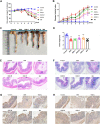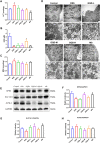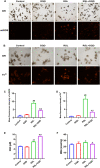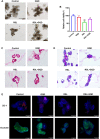Gegen Qinlian decoction (GQD) inhibits ulcerative colitis by modulating ferroptosis-dependent pathway in mice and organoids
- PMID: 37649073
- PMCID: PMC10466729
- DOI: 10.1186/s13020-023-00819-4
Gegen Qinlian decoction (GQD) inhibits ulcerative colitis by modulating ferroptosis-dependent pathway in mice and organoids
Abstract
Background: Gegen Qinlian decoction (GQD) is a classic prescription for treating ulcerative colitis (UC) in traditional Chinese medicine. However, the therapeutic mechanism has not been fully clarified.
Purpose: In the present study, we aimed to evaluate the role of ferroptosis-mediated IEC death in UC treated mice with GQD by using DSS-induced a colitis mouse model and RSL3-induced ferroptosis in intestinal organoids.
Methods: The effects of GQD on DSS-treated colitis were examined via daily body weight, DAI, colon length, HE staining, PAS staining, ZO-1 and Occludin immunohistochemical staining. Ferroptosis was determined by analysis of iron load, MDA, GSH, mitochondrial morphology, and expression of ferroptosis-associated proteins (GPX4, SLC7A11 and ACSL4).
Results: In vivo, GQD administration reduced body weight loss and DAI scores, increased colon length, and improved intestinal histological characteristics and epithelial barrier dysfunction. GQD administration obviously improved the levels of ferroptosis markers (iron load, MDA, GSH, and mitochondrial morphology) and the expression of ferroptosis-associated proteins (GPX4, SLC7A11 and ACSL4). Consistent with in vivo results, GQD administration partially reversed the levels of mtROS, Fe2+ and MDA in intestinal organoids induced by RSL3, and notably improved morphological destruction, histological damage and epithelial barrier dysfunction in organoids.
Conclusions: In this study, we demonstrated that ferroptosis was triggered in DSS-induced experimental colitis and that GQD adiministration could protect against colonic damage and intestinal epithelial barrier dysfunction by inhibiting ferroptosis.
Keywords: Ferroptosis; Gegen Qinlian decoction; IEC death; Intestinal organoids; Ulcerative colitis.
© 2023. International Society for Chinese Medicine and BioMed Central Ltd.
Conflict of interest statement
The authors declare that they have no competing interests.
Figures






References
-
- Ordás IEL, Talamini M, Baumgart DC, Sandborn WJ. Ulcerative colitis. Lancet. 2012;380(9853):1606–19. - PubMed
-
- Molodecky NA, Soon IS, Rabi DM, Ghali WA, Ferris M, Chernoff G, Benchimol EI, Panaccione R, Ghosh S, Barkema HW, Kaplan GG. Increasing incidence and prevalence of the inflammatory bowel diseases with time, based on systematic review. Gastroenterology. 2012;142(1):46–e30. - PubMed
-
- Du L, Ha C. Epidemiology and pathogenesis of Ulcerative colitis. Gastroenterol Clin North Am. 2020;49(4):643–54. - PubMed
-
- Peterson LW, Artis D. Intestinal epithelial cells: regulators of barrier function and immune homeostasis. Nat Rev Immunol. 2014;14(3):141–53. - PubMed
Grants and funding
- ZZ14-YQ-040/training outstanding young scientific and technological talents of Chinese Academy of traditional Chinese Medicine
- ZZ15-YQ-002/training outstanding young scientific and technological talents of Chinese Academy of traditional Chinese Medicine
- CI2021A01012/China Academy of Chinese Medical Sciences Innovation Fund
LinkOut - more resources
Full Text Sources

